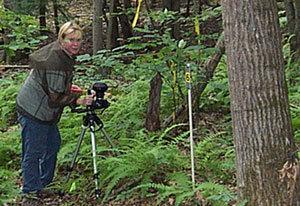 |
Not Just Global Warming
MBL Scientist Finds Carbon Dioxide Makes Poison Ivy Worse
 |
|
Jacqueline Mohan takes a hemispherical photo of the tree canopy, to quantify how much light is reaching the forest understory environment, at the soil warming experiment at Harvard Forest, Petersham, MA.
|
|
MBL,WOODS HOLE, MA—Carbon dioxide is getting a bad rap lately for all that it contributes to global warming. Now rising CO2 levels may exacerbate another problem: poison ivy. New research by an MBL (Marine Biological Laboratory) scientist indicates that the prevalence, and itchiness, of poison ivy may get worse if carbon dioxide levels continue to increase.
"Do what you should be doing already - avoid poison ivy," said Jacqueline E. Mohan about the problem.
Mohan, a postdoctoral scientist at the MBL's Ecosystems Center, was the lead author for a study on the effects of increased carbon dioxide on poison ivy (Toxicodendron radicans). The ivy grown under high carbon dioxide grew twice as much over five years as the ivy exposed to today's level of the greenhouse gas. Also, ivy grown in high carbon dioxide produced a more allergenic version of urushiol, the compound that causes itchy rashes for about 80% of people exposed to poison ivy.
|
|
|
Poison Ivy (Toxicodendron radicans)
|
The research, published recently in the Proceedings of the National Academy of Sciences, was part of the Duke University Free-Air CO2 Enrichment experiment. Scientists used PVC piping to pump extra carbon dioxide into circular areas of forest, each about 100 feet across. The carbon dioxide was at a level that is predicted for the middle of this century if current trends continue. Carbon dioxide enters the atmosphere from the burning of fossil fuels and from the respiration of all living things. Plants use carbon dioxide for photosynthesis, which is how plants convert energy from the sun into chemical energy for growth and maintenance.
Besides the blistering rashes caused by poison ivy, scientists are interested in Mohan's research for another reason: the choking of the world's forests. Poison ivy is in a class of plants called woody vines. Around the world, woody vines are flourishing to the point where they can smother young trees, which are the "forests of the future," said Mohan. Fifty to 100 years from now, if the level of carbon dioxide continues to rise and carbon dioxide promotes growth in woody vines, "what do we expect our forests to look like?" said Mohan.
Global warming is associated with increased carbon dioxide, but also with a longer growing season and increased nitrogen resources. In her current research with Jerry Melillo at the Ecosystems Center, Mohan is at the Harvard Forest in Petersham, Massachusetts, looking at how poison ivy is affected by all three aspects to see if warming will cancel out or inflate the response to carbon dioxide. "I have a bad feeling," said Mohan, "that global warming will be even better for poison ivy."
For full text of paper, click here.
Funding: This research was funded in part by the U.S. Department of Energy and the National Science Foundation.
The MBL is an international, independent, nonprofit institution dedicated to improving the human condition through creative research and education in the biological, biomedical and environmental sciences. Founded in 1888 as the Marine Biological Laboratory, the MBL is the oldest private marine laboratory in the Western Hemisphere. For more information, visit www.MBL.edu.
|